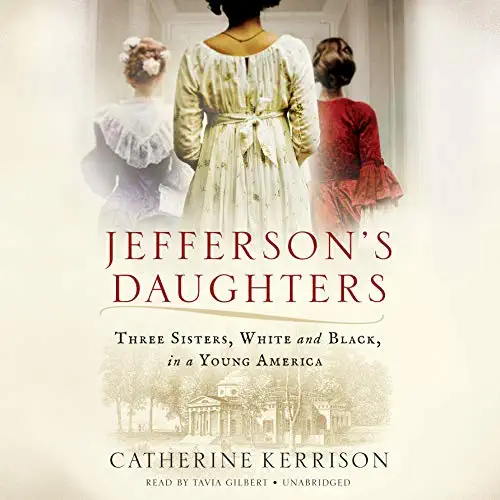Jefferson’s Daughters by Catherine Kerrison
What's It About?
After 40 years of research by historians that was supported with extensive DNA study, the stories that Thomas Jefferson fathered children with an enslaved woman, Sally Hemings, are now accepted as fact.Now to the family archives comes a new book, Jefferson’s Daughters: Three Sisters, White and Black, in a Young America by Catherine Kerrison, a professor of American history at Villanova University.
“Their lives provide a unique vantage point by which to study the complicated American Revolution itself,” said Kerrison at the U.S. National Archives in Washington, D.C., where she recently spoke about her book for Black History Month.
Thomas Jefferson—Founding Father, author of the Declaration of Independence, and third president of the United States—had six children with his wife, Martha Wayles, only two daughters of which lived to adulthood. After Martha died in 1782 at age 33, Jefferson fathered several children with Sally Hemings, including a daughter, Harriet, born in 1801 on Jefferson’s plantation, Monticello.
When the widowed Jefferson was sent to France to negotiate trade agreements, his two daughters, Martha and Maria accompanied him and were sent to the finest school in Paris, where they learned the best Europe could teach them. At the time, the city was a hothouse of intellectual ferment, and the girls attended opera and theater, and became friends with the daughters of French royalty and English diplomats.
All that changed when they returned to Virginia, where Maria became the conventional wife of a planter, Jack Eppes, and died at age 25 after the birth of their third child. Martha soon married Thomas Mann Randolph, a planter and politician who became Virginia’s 21st governor. They had 13 children together.
Martha devoted herself to educating her own daughters, and encouraged them to do the same, refusing to be bound by gendered limitations, said Kerrison during her talk. Meanwhile, Harriet learned spinning and weaving, and worked in the plantation’s cotton factory.
The descendents of Martha and Maria are well documented. Not so are Harriet’s.
In 1822, at age 21, Harriet left Monticello for Washington, D.C., with $50 given to her by Jefferson himself. Her departure caused quite a stir, and it was said at the time she was able to leave because she was Jefferson’s daughter.
Seven-eighths white (she was the granddaughter of the father of Jefferson’s wife, Martha), Harriet reinvented herself as a white woman. Fifty years later, her younger brother Madison told an Ohio newspaper that Harriet married a white man of good standing, but provided no names. “I could name her husband, but I will not,” he told the paper.
Kerrison searched city and church records but did not find anyone she could identify as Harriet Hemings. However, she said, she did learn how slaves were tied together and paraded down Pennsylvania Avenue (under poplar trees planted by Jefferson), and how a race riot in 1835 destroyed prosperous black businesses, fates Harriet escaped by passing.
“Passing is still about survival,” said Kerrison. “What we need to see, and I hope my book shows, is that the legal and social barriers that have separated us by race and gender are as much the work of human hands as the fence that surrounds the Monticello graveyard,” where only Jefferson’s official descendents may be interred.
“That I did not find Harriet Hemings only proves the point that we are all connected,” said Kerrison at the National Archives. “We need to acknowledge the artificiality of systems that separate us, so that we may begin to dismantle them, and embrace our common humanity.”
For more information on the author, please visit her website.
Buy this Book!
Amazon




